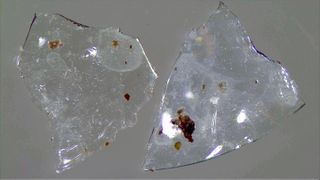Here's What Happens When You Flush Contact Lenses Down the Toilet (and Why You Shouldn't)
Scientists are hoping your answer isn't "flush them down the toilet" or "toss them into the sink."
That's because a new study finds that discarding contacts lenses in these ways may ultimately end up contributing to microplastic pollution in waterways. Microplastics measure under 0.2 inches (5 millimeters) in length — about the size of a sesame seed or smaller — and can wind up in the ocean and the Great Lakes, posing a potential threat to aquatic life, according to the National Oceanic and Atmospheric Administration.
The idea to study the fate of contact lenses came when senior study author Rolf Halden, a professor and director of the Center for Environmental Health Engineering at Arizona State University's Biodesign Institute, started to wonder whether there was existing research on what happened to contact lenses after use. There was none. [In Images: The Great Pacific Garbage Patch]
So, Halden and his team started with a survey of 139 individuals, including both contact lens wearers and non-wearers. They found that "15 to 20 percent of contact lens wearers are flushing contacts down the sink or toilet," lead study author Charlie Rolsky, a doctoral student in biology at the same institution, said in a statement. "This is a pretty large number, considering roughly 45 million people in the U.S. alone wear contact lenses."
But what happens to these lenses when they're swept down the drain? They end up in wastewater treatment plants — and that's where things get a little dicey.
Along the way, wastewater passes through filters meant to keep out larger bits of waste, but because contact lenses are made from flexible material, they can fold up and get through the filters, The New York Times reported.

Wastewater is also mixed with a variety of bacteria, which are tasked with breaking down biological waste. To better understand how these bacteria affect contact lenses, the researchers soaked five different contact lens materials in mixtures containing these bacteria for varying amounts of time. They found that lenses came out largely intact — though further analysis showed that the bacteria had weakened some of the chemical bonds in the materials, making it easier for the lenses to fragment into smaller pieces. This, ultimately, is what could lead to the formation of microplastics, the researchers said.
Sign up for the Live Science daily newsletter now
Get the world’s most fascinating discoveries delivered straight to your inbox.
Another experiment, on 11 different types of contact lenses, found that most lenses are denser than water, meaning they'll sink. This could be particularly dangerous for bottom-feeders on the seafloor that may ingest the microplastics from the lenses, Halden said.
The new research was presented yesterday (Aug. 19) at the National Meeting & Exposition of the American Chemical Society in Boston. The findings have not yet been published in a peer-reviewed journal.
Originally published on Live Science.


Hundreds of black 'spiders' spotted in mysterious 'Inca City' on Mars in new satellite photos

China green-lights mass production of autonomous flying taxis — with commercial flights set for 2025

'We have combined two marvels of modern medicine': Woman gets pig kidney and heart pump in groundbreaking procedures
Most Popular

